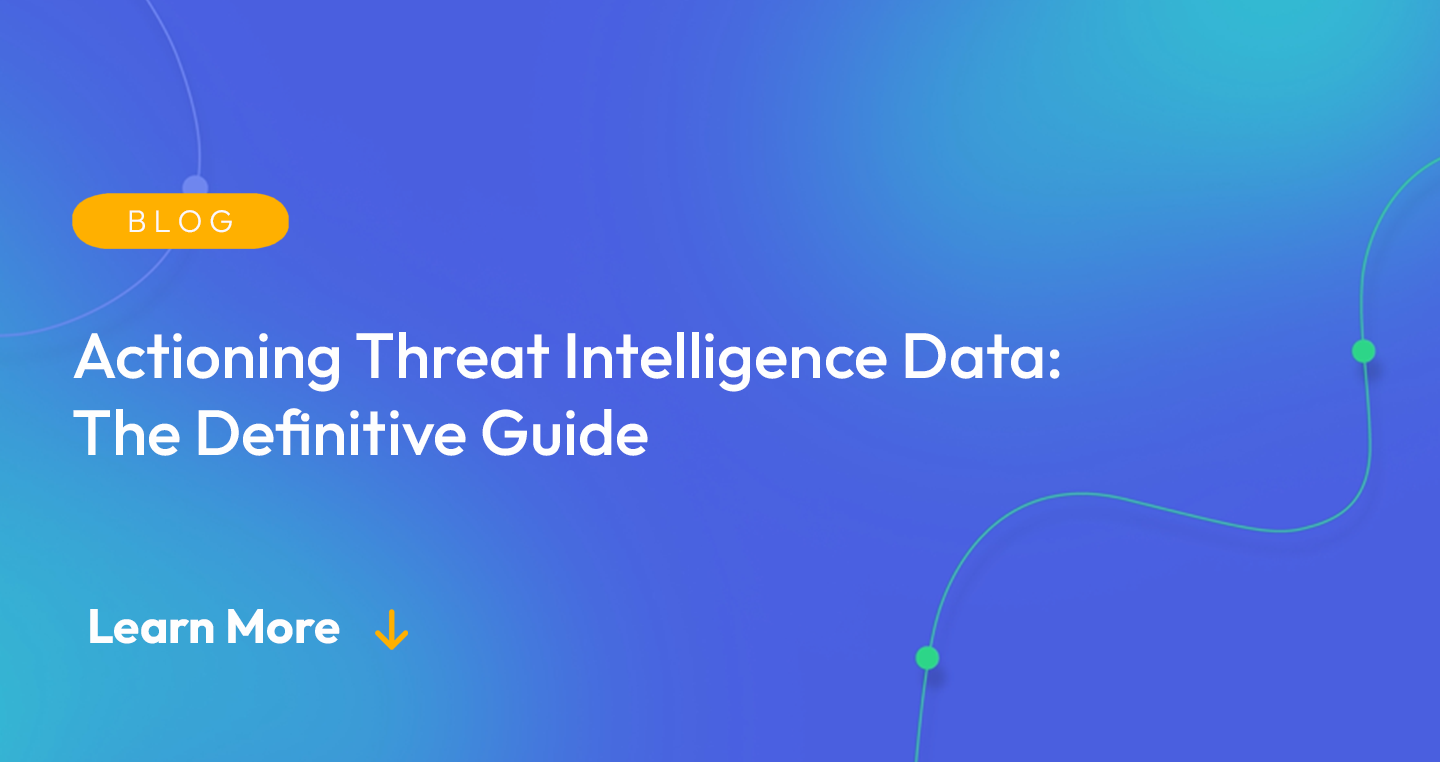
Threat intelligence data plays a pivotal role in strengthening any organization’s defense systems. Actionable threat intelligence is critical, and it is an important function in active defense measures. It provides immense benefits through providing context and priority. Adopting a SaaS platform for threat intelligence handling includes useful features such as automation, consolidated data sources, real-time notifications, AI functionality, and adaptability.
By capitalizing on cyber threat intelligence data and employing a sturdy SaaS platform, organizations can bolster their cybersecurity barriers and effectively tackle the continually shifting cyber threat landscape.
Understanding the Basics: Threat Intelligence Data
What is Threat Intelligence Data?
In essence, threat intelligence data refers to the collated information about potential or current threats that could harm an organization. This information is typically gathered from various sources, providing a comprehensive understanding of the potential cyber threats landscape.
The fundamental aim of threat intelligence data is to aid organizations in making informed decisions about their cybersecurity. It involves collecting, parsing, and analyzing vast amounts of data to provide insights into potential cyber threats, threat actors, and their tactics, techniques, and procedures (TTPs).
Threat Intelligence Data and Usability
The value of threat intelligence data lies not just in its existence but in its usability. Raw data, on its own, can be overwhelming and difficult to decipher. However, when refined and accurately interpreted, this data transforms into actionable intelligence – a precious resource that allows organizations to proactively defend against imminent threats.
Furthermore, threat intelligence data isn’t just about identifying potential risks. It’s a strategic tool that helps in prioritizing resources, enhancing security protocols, and driving effective incident response actions. Ultimately, it empowers companies to anticipate, prepare, and combat cyber threats, fortifying their digital infrastructure and safeguarding their valuable assets.
The Importance of Actionable Threat Intelligence in Today’s Digital Landscape
The digital landscape continues to morph into a complex matrix of information exchange. While this has ushered in an era of remarkable innovation and convenience, it has also brought with it new challenges – especially in terms of cybersecurity. That’s where the importance of actionable threat intelligence becomes apparent.
What Actionable Threat Intelligence Provides
Actionable threat intelligence is not just about possessing data on potential cyber threats. It’s about distilling this data into digestible insights that can be used to fortify defenses, inform strategy, and ensure resources are allocated effectively. Actionable intelligence can provide organizations with a clear understanding of the risks they face, offering the foresight needed to implement protective measures against potential attacks.
In an environment where cyber threats are rapidly evolving, staying reactive is no longer sufficient. Companies must transition from a state of constant catch-up to a position of proactive defense, and actionable threat intelligence is pivotal to this shift. It offers an opportunity to preemptively identify and counteract threats, rather than merely responding post-breach.
Moreover, actionable intelligence brings context to threat data, illuminating the who, what, when, where, why, and how of potential attacks. This clarity enables organizations to not only understand the nature of the threats they face, but also the motivations and tactics of threat actors. This level of insight is crucial for developing robust, targeted defenses that adequately protect against specific threat vectors.
In a time where the cost and frequency of cyber attacks are escalating, leveraging actionable threat intelligence data has become a critical necessity. It is no longer an optional advantage, but a vital component of any comprehensive cybersecurity strategy.
Techniques for Turning Raw Threat Data Into Actionable Intelligence
While raw threat data provides a wealth of information, its real value comes from its transformation into actionable intelligence. The sheer volume of data available can be overwhelming, making it crucial to have a strategy for extracting the most pertinent information.
Here are several key techniques for converting raw threat data into actionable intelligence:
Data Aggregation
The first step is to gather data from multiple sources, including open source intelligence (OSINT), social media, log files, threat feeds, and even human intelligence. This process of data aggregation allows for a broader perspective of the threat landscape, reducing the risk of blind spots in your cybersecurity framework.
Data Normalization
Once data is collected, it needs to be standardized or normalized. Normalization ensures that data from disparate sources can be easily compared and analyzed, converting it into a consistent format that can be interpreted by your threat intelligence platform.
Threat Analysis
After data normalization, the next step is threat analysis. This involves sifting through the aggregated and normalized data to identify patterns, trends, and anomalies that could signify a potential threat. Tools like AI and machine learning can be incredibly beneficial in this phase, automating the process of detecting complex patterns and speeding up threat detection.
Contextualization
Contextualization adds an extra layer of relevance to the analyzed data. By contextualizing data, organizations can understand the potential impact of a threat in relation to their specific business operations. Factors like the nature of your business, size, industry, and geographical location can all influence the severity of different threats.
Integrate the world’s easiest to use and most comprehensive cybercrime database into your security program in 30 minutes.
Prioritization
Prioritization comes after identifying and contextualizing threats. Not all threats are created equal and understanding which ones require immediate attention is key to effective threat management. Prioritization should be based on factors such as:
- Potential damage
- Likelihood of occurrence
- Resources required for mitigation
Dissemination
The final step is the dissemination of the actionable intelligence to the relevant stakeholders in your organization. This could include IT teams, executive leadership, or other personnel responsible for implementing cybersecurity measures.
By following these steps, organizations can successfully turn raw threat data into actionable intelligence, enabling a proactive, informed approach to cybersecurity.
Leveraging Your SaaS Platform for Optimal Threat Intelligence Management
In today’s fast-paced digital world, relying on manual processes to collect, analyze, and action threat intelligence data can leave organizations vulnerable to the rapidly evolving threat landscape. A robust SaaS platform, specifically designed for threat intelligence management, can be a game-changer. Here’s how you can leverage your SaaS platform for optimal threat intelligence management:
Automation of Data Collection and Analysis
One of the major benefits of a SaaS platform is automation. By automating the collection and analysis of threat data, organizations can streamline the time-consuming process of data gathering and normalization, ensuring that they are always equipped with the latest intelligence.
This allows your security teams to focus more on strategic tasks rather than being consumed by the tedious task of data collection and analysis.
Integration of Multiple Data Sources
A comprehensive SaaS platform can integrate data from a wide variety of sources, enabling a holistic view of the threat landscape. Whether it’s OSINT, commercial threat feeds, industry reports, or internal incident data, integrating these diverse data sources can enhance the richness and relevance of your threat intelligence.
Real-Time Threat Alerts
SaaS platforms for threat intelligence often provide real-time alerts for identified threats. This ensures that your team is always informed about potential threats, enabling swift response times and reducing the chances of a successful cyber attack.
AI and Machine Learning Capabilities
Many modern SaaS platforms incorporate AI and machine learning technologies. These can be invaluable for identifying patterns, predicting potential threats, and providing in-depth insights that would be almost impossible to derive manually.
Furthermore, these technologies allow your threat intelligence to continually learn and adapt to evolving threats.
Scalability and Flexibility
Finally, SaaS platforms offer scalability and flexibility. As your organization grows, your threat intelligence needs will evolve. SaaS platforms can easily scale to match your growth and change according to your shifting needs, ensuring that your threat intelligence management remains robust regardless of how your organization evolves.
In conclusion, a robust SaaS platform for threat intelligence management is not merely a tool, but a strategic partner that empowers your cybersecurity efforts. By enabling automation, integration, real-time alerts, AI capabilities, and scalability, a SaaS platform can significantly enhance your ability to transform raw threat data into actionable intelligence, fortifying your organization’s defenses against the ever-evolving world of cyber threats.
Actionable Threat Intelligence with Flare
Actionable threat intelligence plays a big role in proactive defense and brings immense value in terms of contextualization and prioritization. A SaaS platform can optimize threat intelligence management to simplify parsing through data for actionable insights.
Flare monitors billions of leaked passwords and other data points across illicit sources to provide your security team with actionable alerts. The AI Powered Assistant boosts actionable intelligence by translating and contextualizing dark web posts, cutting out noise by 50%, automating public GitHub repository takedowns, and more.
Start your free trial today.


